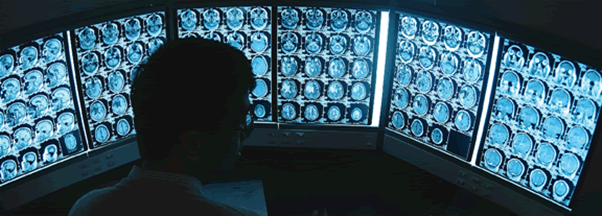Compounding the Issue
Alzheimer’s and Atherosclerosis have apolipoprotein-E in common
October 29, 2007
By Russ Hudson
Biological scientist Nilay Patel, biochemist Jonathan Stoddard and their research students are looking for a way to control a key factor in the onset of both Alzheimer’s disease and heart disease. If they succeed, their therapy stands a good chance of stopping Alzheimer’s in its tracks.
As with many things in the body, balance is everything. Too much apolipoprotein-E (apoE) in the brain can lead to Alzheimer’s; too little in the body risks atherosclerosis, a potentially fatal heart disease. Patel’s research is based largely on the premise that if apoE can be reduced appropriately in the brain, it can delay or stop Alzheimer’s disease; increased appropriately in the body, it could inhibit formation of atherosclerotic plaques, the deposits that can block arteries.
Because many factors can influence the outcome, “what we need are compounds that can affect the apoE levels as needed and where needed,” said Patel, assistant professor of biological science. “So, my students and I are collaborating with Jonathan Stoddard, assistant professor of chemistry and biochemistry, and his students. Jon and I design the compounds, which are synthesized by his students and tested by mine.”
Lipoproteins are responsible for carrying cholesterol and other fats through the bloodstream and are essential for the normal breakdown of fat molecules. ApoE is a major component of specific low-density lipoproteins (LDL) that remove excess cholesterol from the blood and carry it to the liver where it is broken down for excretion. Maintaining normal cholesterol levels is essential for the prevention of Alzheimer’s and cardiovascular diseases, including heart attacks and stroke.
With one in five people genetically predisposed to contract Alzheimer’s at a rate more than seven times that of the general population, Patel said, “genotype-specific, custom-designed therapies like ours may be the way of the future.”
Advances in various branches of medicine during the 20th century have extended the average lifespan, dramatically increasing the incidence of neurodegenerative diseases, Patel said. “Previous generations didn’t live long enough to face these illnesses,” he added.
The most common neurodegenerative disease is Alzheimer’s, he said, “Estimates suggest that 4 million U.S. citizens are currently afflicted by Alzheimer’s, with a total domestic population of 14 million expected by the year 2050.”
In his quest to understand Alzheimer’s disease pathogenesis, Patel is investigating the possibility of starting a new line in his research using embryonic stem cells from mice. “The stem cells could be used to develop neuron and glial cells (cells in the nervous system) which then could be used for testing,” he explained.
“This project combines the expertise and energies of two of our newer faculty members and their students, providing valuable experience in carrying out scientific research,” said Stephen Murray, dean of the College of Natural Sciences and Mathematics.



